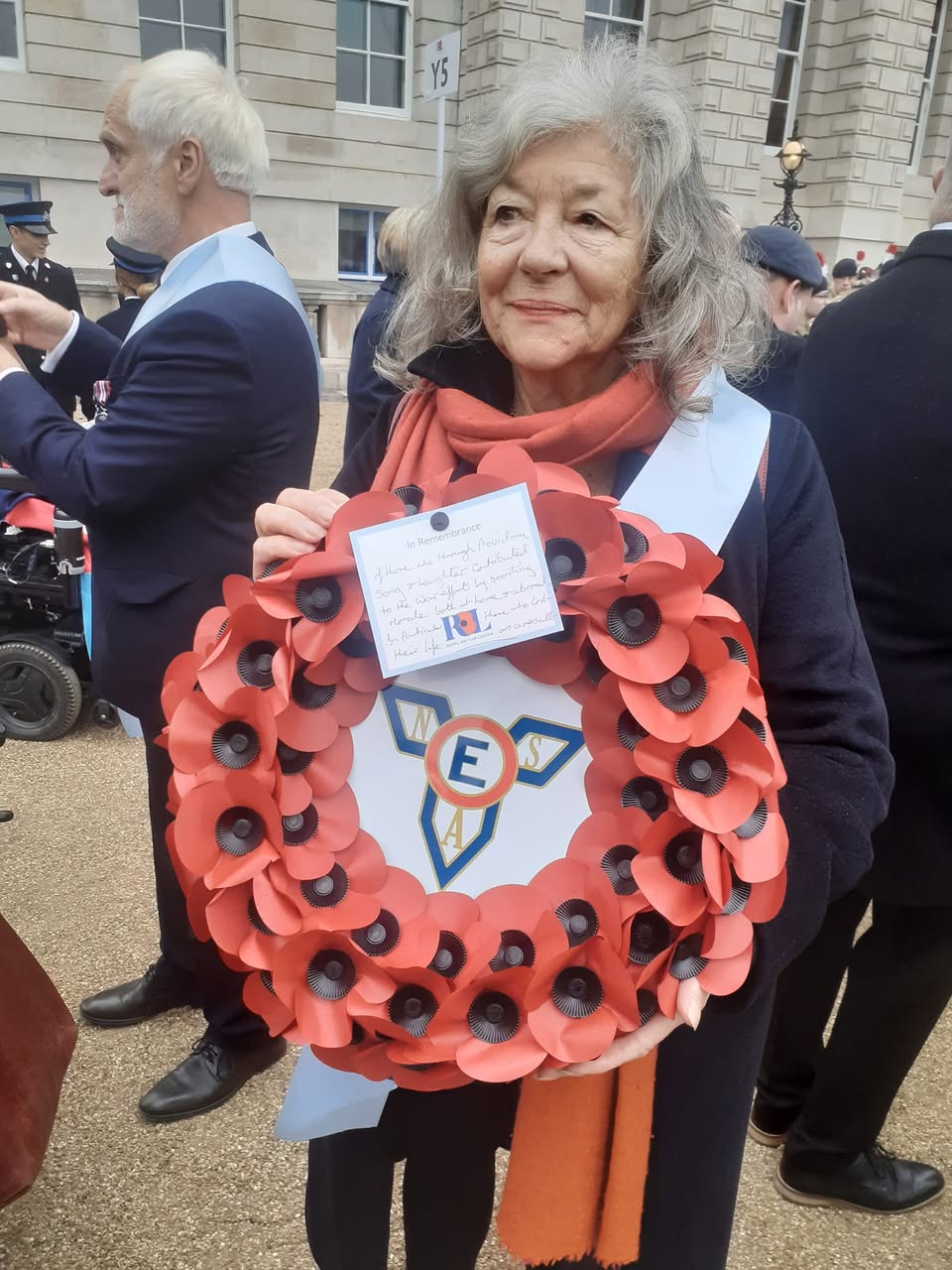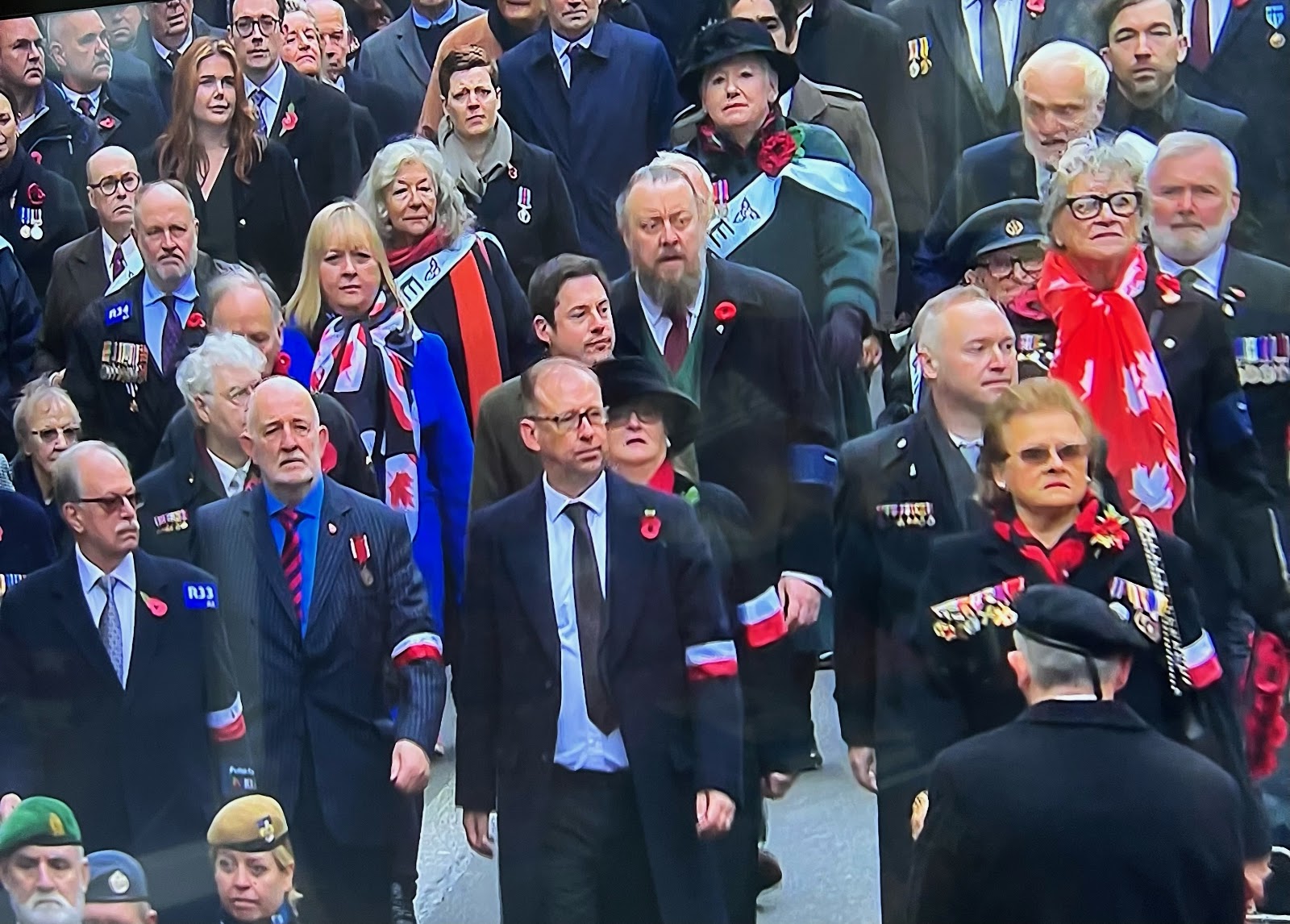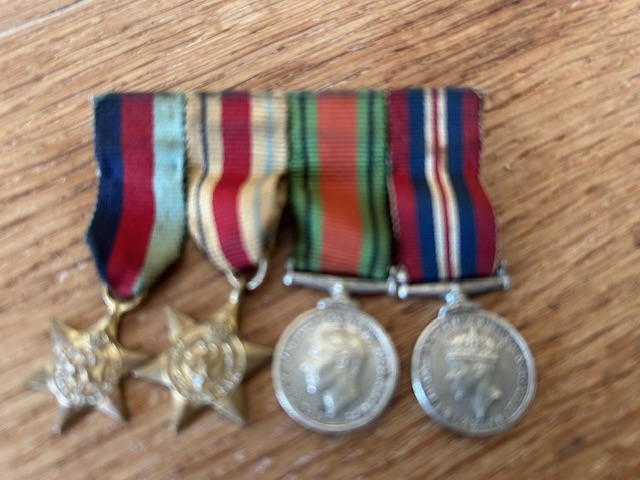This year of 2024 was the first time that members of ENSA, or family members of those who had entertained troops during WWII, were represented in the march on Remembrance Sunday. We were a tiny band of six but we were strode proudly for the thousands of men and women who had entertained servicemen and women while they were fighting for their country.
Here we are again marching past the Cenotaph, wearing the sash of ENSA. It was a very memorable and moving moment. Our wreath was laid amongst the thousands of others. Red upon red, all those poppies for peace.
Apologies that this photo is a little blurry. These are my father's medals. I had never really asked myself what they were awarded for until I started to write this History Girls post. The first medal, I believe, is a WWII British Africa star. Daddy would have been awarded this one because he spent all his war in Africa and the Middle East.
Every ENSA member was awarded the Defence Medal. In Daddy's collection above, it is the third one along.
Dame Very Lynn. 1917 - 2020
Dame Very Lynn, an abidingly famous ENSA artiste was a symbol of the wartime spirit, also a symbol of all that was waiting back home: wives, sweethearts, sisters, mothers. She was greatly loved and became known as the 'Force's Sweetheart'. She was awarded the Burma Star for entertaining British guerrilla units in Japanese-controlled Burma. She was also awarded the War Medal 1939 - 1945. She and I met on many occasions later when I had started working as an actress and we were involved in various charity shows together. Vera was a truly lovely lady, modest, gracious and generous.
Daddy's War Medal is above: the fourth one along in the pic.
When my father used to recount his tales of those 'exotic' days in Africa, it all sounded such fun and gung-ho but it could also be very dangerous.
It was compulsory for West End Stars to entertain the troops during at least one six-week tour a year. Sometimes entertainers who were not in the armed forces were sent abroad to entertain. Basil Dean worried that if any of these artistes were captured, they were at serious risk. If they were caught and not in uniform, Dean feared they might be taken for spies, which was a very real possibility. At Dean's behest uniforms were introduced for those civilians/stars who had accepted to entertain in war zones. The uniforms consisted of standard pattern battle dress and war theatre uniforms such as Jungle Green bush jackets. The only insignia allowed on the jacket was the standard ENSA shoulder titles. Although the civilian performers had no rank, all ENSA performers were granted officer status so that they could use the mess facilities. History has it that the only artiste never to wear uniform was Tommy Trinder who, when offered the uniform, said, "No, thanks. If I get captured, I deserve to be shot!"
As far as I am aware, the only ENSA member killed in the war was a nineteen-year-old girl, a tap dancer and acrobat. Vivienne Hole performed under the stage name of Vivienne Faye. On 23rd January 1945 in Normandy, she was being driven between shows as a passenger aboard a truck carrying stage scenery which strayed into a minefield and exploded. She was buried with full military honours in the Sittard War Cemetery. What a tragic end for one so young and at such a late stage in the war.
When I was a child, RAF Gang Show reunions were held in London on an annual basis. Daddy always attended. He was immensely proud of his contribution to Ralph Reader's shows. Amongst the soldiers he performed with were Peter Sellers and Tony Hancock. Peter Sellers began with ENSA as a drummer. Later when performing with Gang Show units, he developed his extraordinary skills for improvisation. Both Sellers and my father loved to play the ukulele and I have often wondered whether they performed together. My father's ukulele, and his banjo, sit in my writing room and they a great source of comfort and inspiration.A little joke: Because sometimes the shows were a bit of a shambles and not always entirely properly rehearsed, the troops used to joke that ENSA actually stood for, 'Every Night Something Terrible.'
As I have written above, ENSA has never been recognised at the Remembrance Day March, until this year. We little band of six were the first to march and give the salute for al those wonderful people. Also, importantly, no Memorial exists to honour all those hundreds of thousands who spent the war entertaining others, but there is a move to change this. Below is a crowdfunding site to help pay for the cost of the memorial stone and its placement. If you or someone in your family have ever been entertained by anyone from ENSA, please think of making a small donation.
I have posted the same photo twice because the first version is clearer but cuts out the gentleman standing on the left. My father is the lad giving all the ladies a piggyback. I think these 'girls' performed in the shows with Daddy, or were in military service in Africa. According to Daddy's writing on the pic, it was taken in Durham in South Africa in 1944. If anyone knows who the other man is or can recognise any of the ladies, I would be thrilled to hear from you.
After my generation, there will be no one left to remember all these past performers if no Memorial stone is erected in their memory. There is a link below for donations. Thank you.
Also, below, is a link to an article I wrote for the Mail on Sunday Travel recounting a visit I made this year, 2024, to Alexandria in Egypt. I made the journey partly to follow in the footsteps of my father.
https://www.dailymail.co.uk/travel/article-13582619/Alexandria-Egypt-Carol-Drinkwater.html
My travel book The Olive Route covers many of the countries where my father was stationed in Africa and the Middle East.
https://www.crowdfunder.co.uk/p/ensa-memorial-appeal-1202671























